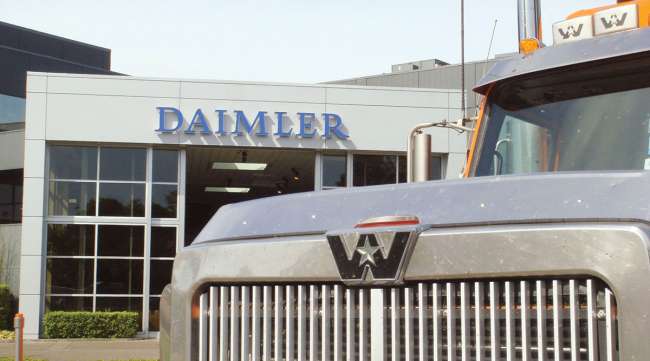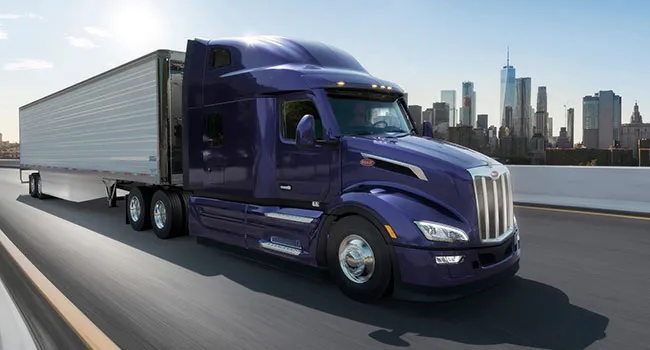Staff Reporter
Class 8 Sales Fall for Fourth Consecutive Month in November

[Stay on top of transportation news: Get TTNews in your inbox.]
Class 8 retail truck sales in November fell year-over-year for a fourth consecutive month, Wards Intelligence data showed.
Sales fell 17.5% to 19,027 units from 23,075 trucks in the same month in 2022 while also dropping 11.2% sequentially from 21,417 units sold in October.
Industry observers were expecting a month-on-month pullback in sales. November usually sees a 9%-10% decline in sales compared with October, so 11.2% is not a huge difference from the mean, ACT Research Vice President Steve Tam told Transport Topics.
Sales for the month decreased for six of the seven major truck makers year-over-year, Wards data shows.

Peterbilt owned the second-largest market share, 16.8%, after the 30.5% of DTNA's Freightliner brand. (Peterbilt)
Daimler Truck North America’s Western Star was the one exception, seeing a 53.3% spike in sales to 713 units from 465.
Sister DTNA brand Freightliner won the largest market share at 30.5%, but sales declined 31.4% to 5,796 units from 8,453 trucks in November 2022.
Sales at Peterbilt Motors Co., which snagged the second-largest market share at 16.8%, decreased 11.5% to 3,198 from 3,612. Fellow Paccar unit Kenworth Truck Co.’s sales fell 18.5% to 3,050 from 3,743.
Volvo Trucks North America’s sales fell 6.6% year-over-year to 1,980 units from 2,121, according to Wards. Mack Trucks’ sales decreased 20.7% to 1,321 from 1,665. Both are Volvo Group brands.
“The heavy-duty market is seeing pullback from peak 2023 demand levels due to a decline in loads and pricing in the freight market,” said Jonathan Randall, president of Mack Trucks North America. “When that large segment of the industry experiences pricing pressure with declining tonnage, pullback is typical and expected.”
Navistar’s International brand saw sales dip 2.1% to 2,952 from 3,016.
ERoad's Craig Marris gives advice on carving out a practical, effective road map to a greener and more efficient fleet. Tune in above or by going to RoadSigns.ttnews.com.
“November could have been a slightly higher number, but for the industrial action,” said Tam, noting the maxim that you cannot sell what you have not built.
Production at Mack Trucks facilities only reached full capacity in late November after employees returned to work following a six-week strike. Mack Trucks on Nov. 15 announced that members of the United Auto Workers union ratified a collective bargaining agreement after walking out Oct. 9. The truck maker’s facilities started to ramp up Nov. 20 after UAW members ratified the five-year CBA covering about 3,900 employees at facilities in Pennsylvania, Maryland and Florida, a company spokeswoman told TT.
Mack has not disclosed how much production was lost. However, according to S&P Global Mobility estimates the strike cost Mack just more than 1,800 Class 8 vehicles. That said, S&P analysts expect the original equipment manufacturer to make up for the downtime in the coming quarters.
Through the first 11 months of 2023, sales were 8% higher on an annual basis at 243,253, compared with 225,163 in 2022.
Sales typically increase in December, and this year is expected to be no different.
“December is the ‘Miracle Happens Here’ month,” Tam said. “OEMs pull out all the stops.” Truck manufacturers, their employees as well as dealers have sales targets and performance targets they are hoping to meet, and December is their last chance to do so.
OEMs are expecting December production to total between 21,000 and 22,000 trucks, said Tam. “They’re really going to have to pull out all the stops,” he said.
ACT’s 2023 Class 8 sales forecast is 275,000 trucks, which would be a 6.5% year-over-year increase.
To reach that figure, December sales would need to total 32,000 to 33,000 trucks, which would require a month-over-month increase of at least 68%. ACT expects a 20% jump in sales on a monthly basis.
It is highly debatable whether truck makers have the parts or the labor to meet such a tall order, particularly with contractual shutdowns scheduled for the holiday season, according to Tam.
Looking further forward, ACT expects a 23%-24% decrease in sales in 2024, which Tam said was heavily influenced by the U.S. freight market outlook, where soft rates are hurting the smallest players in the segment harder than their larger competitors.
Want more news? Listen to today's daily briefing below or go here for more info:





